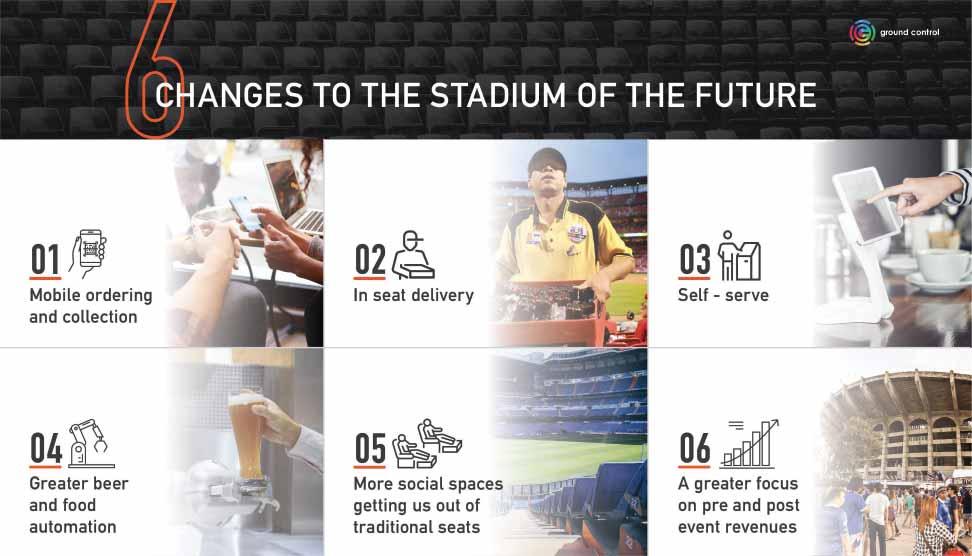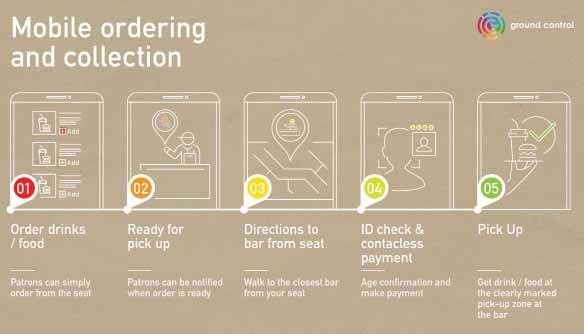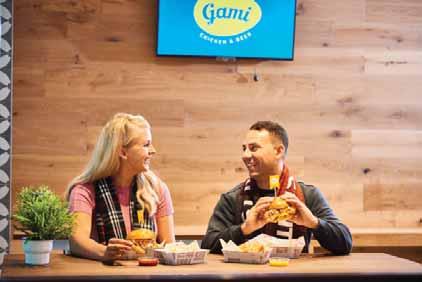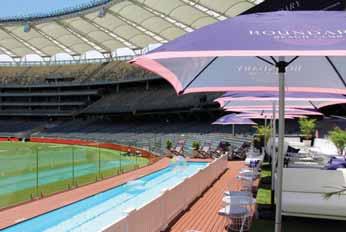
10 minute read
Reshaping the Stadium of the Future
Adam Summerville considers six critical areas for stadiums and entertainment venues to address in the post-Coronavirus environment
With the time afforded to us during the recent Coronavirus lockdown, we have been able to stop and attempt to understand what the future holds and try to understand how stadiums, arenas, racecourses and other leisure precincts will evolve post COVID-19 when it comes to its hospitality and F&B offers and how they protect this important revenue stream and component of the fan experience.
Advertisement
It’s a question that all operators and even architects will need to grasp as we come through this. For the immediate future, and perhaps in its entirety moving forward, business as usual may not ever be the same again. While authorities may restrict attendance numbers at stadiums, arenas and racetracks for the near future, perhaps the bigger question is the psychological one of patrons - in the future, will they want to be jammed into a seat next to 40,000 others? Distancing, contactless transactions, technology and automation are with us now and will form a big part of our lives going forward.
In addition, stadiums and entertainment venues are going to need to meet the requirements of governments and statutory authorities as well as the psychology of fans and patrons in the post Coronavirus world.
1. Mobile Ordering and Collection Mobile ordering and collection has been accelerating in many areas of hospitality over the past year. Tech operators such as me&u are at the forefront of this development and hospitality operators are embracing the opportunity to assist with lowering labour costs as well as providing faster and better customer experiences. Some of Australia’s biggest and best hospitality operators were reporting up to 35% of all F&B spend at venues coming through the tech ordering systems and this is expected to grow exponentially once they re-open, they are already reimagining the customer experience. Stadiums and venues should be no different. There is virtually no barrier to mobile ordering and collection at a stadium, arena or leisure precinct. A customer ordering a beer

won’t even require a pick up time as the process is so fast, they simply order from the seat and by the time they get to the bar the beer will be ready. The tech can also provide clear directions to the bar and ample opportunity for up-sell during the order (from an entry level to a craft beer, or add-ons for (such as a packet of crisps). Payment is receipted automatically making the process contactless. It simply needs a sectioned off clearly marked pick-up zone at the bar, with relevant staff taking care of responsible service of alcohol protocols and age confirmation.
There are other added benefits with the tech such as instantaneous F&B promotions (dynamic pricing) throughout the event (including pre and post activities or happy hours), plus all the data being collected allowing for some analysis of what the sales are and where the sales are coming from, further assisting with cost reduction over time. The beauty and advantage for the stadium operators is that the tech is already being widely used by many of the current stadium fans attending the venue. They are used to it at their local venues (and will be more so over the next 18- 24 months) and will be much less hesitant to use it than a stadium specific option that they are not familiar with and have been tried and unsuccessful over time. 2. In Seat Delivery We believe this to be the ‘holy grail’ for stadiums and arenas and it is something we are focused on helping our clients achieve both for greater revenue opportunities and the changing habits and needs of Gen Z and Y. We propose a ‘fly-in-fly-out’ seat system that would see venues’ seating configuration designed so that multiple middle seats can be easily removed to create more aisles with no one more than six seats from an entry/exit point.
When we originally proposed this, it was on the basis of ensuring easy access for the delivery staff and while that hasn’t changed it now has the extra benefit of instantly providing clear distancing between groups of fans at stadiums. The whole F&B experience is an exact repeat of the above mobile ordering process except the customer simply selects in seat delivery instead of pick up. The tech does the rest with precise seat and row number details with the deliverer being responsible for responsible service of alcohol protocols and age confirmation. In seat delivery has the added benefit of reducing crush periods at bars when quarter time, half time and three-quarter time roll around, by spreading the load. Virtually every stadium will have bars in each quadrant that could potentially be fully dedicated to pick up and delivery.
As a potential likelihood that requires stadiums to remove or section-off every second row, clearly In-Seat Delivery creates even more opportunity and appeal. We believe this is something every stadium operator should be considering right now.
3. Self Serve Self Serve is not new. However, it has been under-represented in the stadium and arena space over the years, especially in Australia. Even new stadium design is not embracing it as much as it potentially could. It has always had its benefits (such as speed and spreading the load) but as technology gets better it is definitely producing a more premium quality product, more efficiently, and without the need for experienced (and expensive) operators. Combining this technology with mobile ordering creates the full benefit of being contactless, with many systems no longer requiring touchscreen capability. Even where touchscreen is in place, a simple ‘hand sanitiser’ solution can be in place for pre and post touch. For racecourses and other leisure activities that ramp up and down, self-serve The new Gami F&B outlet at Melbourne’s Marvel Stadium. has the added advantage of adding in additional POS opportunities that can be manned with minimal staff or used for carnival days or where demand has crowds further away from traditional drinking locations or outlets. 4. Automation Now is the time to really look at its advantages and how it can simply drive a better operating model. Anyone who has been to a stadium or arena has more than likely been faced with an over poured beer that doesn’t present very favourably. When you add the fact that this beer is in a plastic cup and typically priced at a premium, the value gap in the consumer’s mind grows. Beer is one place that iOS is getting plenty of attention in the world of automation. There are multiple automated dispensing units now (such as ‘beerjet’) that address the problems of speed and quality. Coffee presents a similar opportunity. It is more acceptable these days to purchase coffee from a fully automatic machine, simply because the quality of end-product from these machines are very, very good. Long gone are the days one coffee option per machine. Machines these days have multiple blends (taste profiles) as well as the ability to order your favourite latte or cappuccino. You can even choose for it to be hot or iced. Automation on the food front has progressed tremendously, but the biggest gains are more for operators. Advances in food technology now means there is equipment on the market that can be used to cover a wide array of cuisines, removing the need for expensive back-of-house culinary experience, as well as reducing space requirement and, the knock-on effect, a significant reduction in capital cost. Moving forward finding ways to improve quality and speed as well as a lower reliance on expensive staff is more vital than ever. 5. Social Spaces More social spaces might sound counterintuitive as we talk about distancing but they are vital for the future attraction, F&B revenue, for stadiums and arenas. As social and experience-driven consumers, Gen Z and Gen Alpha - the fans (and customers) of the future - want these spaces so providing them with the right opportunities to watch live sport in a social environment is key. The impact of COViD is also likely to have a lasting impression on these generations and it is unlikely they will find it overly attractive to squeeze past dozens of people to get to their seats in Bay 41, Row G Seat 113. Social spaces where F&B can be consumed while being a part of the match day experience will be valued, and this is where lost revenue opportunities from crowd drops and restrictions can be recovered. With most stadiums and arena in Australia only sold out for less than 10% of all events, operators can dedicate semi-permanent social spaces taking up areas of the seating bowl as Cricket Australia did with the ‘boundary


Pop up hospitality at Perth’s Optus Stadium.
social’ across the summer test matches. Spaces there are, and should continue to be, premium in nature however open to the general public creating opportunities to double, or even triple, spend per head. Stadiums should also look at engaging the best high street operators to activate these spaces as they will bring the glam and high end expertise (not to mention data base and social reach) that the incumbent F&B operator would be unable to do. The capital costs will stack as it can be used across the season(s) and nudging your brewery partner for a contribution cannot hurt also.
6. Pre and Post-Event Revenues Pre and Post revenue will now be more important than ever as every dollar in F&B sales will go some way to repairing damaged businesses and P&Ls. It’s time to get some mongrel around this and not accept that the role of pre and post revenue is taken up by the local pub and restaurants in close proximity. It’s your event and you should benefit first and foremost.
Start with the most basic - ensuring that you are at the very least serving up until the full-time siren. We get such limited game time that closing down bars ten minutes before the end of a match or at three quarter time is a luxury we simply cannot afford. Of course, all normal responsible service of alcohol protocols apply however now is the time to be meeting with the licensing authorities, challenging restrictions that, in some cases, go back 30+ years and have not moved with the times. What happens when the bars close is that the fans simply leave the stadium to find a drink elsewhere - time to get inwardly mean on this, every dollar counts much more than it did previously. Be strategic and look at which bars are most likely to continue to be busy right up until full-time and potentially after.
With the new ‘rules’ around distancing egress after (and before) games may need to be staggered in any event so capitalising with F&B as the anchor seems smart. Regardless, having a great bar or social space for pre and post F&B revenue should be at the top of every stadium’s wish list.
In summary, stadiums and arenas must be adapting and evolving their F&B strategies. Stadiums with some ‘mongrel’ to progress to more advanced tech and automation, with great experiential concepts, and clever thinking (such as in-seat delivery) have the greatest chance not only to recover the lost revenue of 2020, but to grow F&B revenues exponentially by focusing on pre, during and post event dollars. Food and Beverage Consultant Adam Summerville is Managing Partner at Ground Control.
With partner Kevin Zajax, Ground Control provides solutions to increase return on investment and awardwinning F&B experiences. Services include concession planning and selection, business streamlining, crisis management and growth strategies for airports, brands and stadiums. Email: adam@groundcontrolglobal.com, www.groundcontrolglobal.com


P 1300 897 117 E info@quayclean.com.au quayclean.com.au
CLEANING PARTNERS











